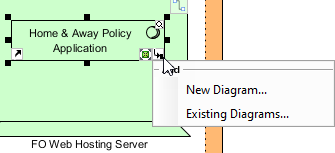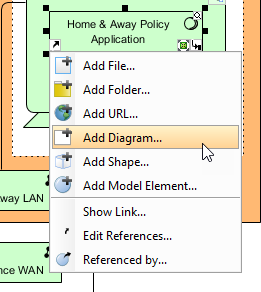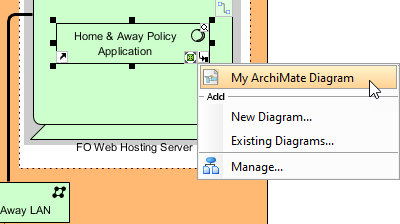Hi Pino,
Thank you for your post. There are two methods to relate a model with a diagram.
Method 1: Sub-diagram
Sub-diagram is a diagram owned by a model element. When you move a model to another location within the model hierarchy, the diagram will follow, and when the model is being deleted, the diagram will be deleted as well. In other words, a sub-diagram is a part of a model element.
To create a sub-diagram:
- Click on the shape (For your shape, it should be an ArchiMate shape)
- Click on the tiny arrow icon at the bottom right of the shape. If you want to create a new diagram, select New DIagram. If you want to make an existing diagram become a sub-diagram of the selected element, select Existing Diagram…

- If you have selected to create a new diagram, you will be prompted the New Winodw window. Select the type of diagram to create and click Next.
You said you want to create a heat map, I am not sure if you want a statistical heat map or an ArchiMate -style heat map. We support both heat map chart and ArchiMate.
Method 2: Reference
Reference is a kind of loose connectivity. While sub-diagram is a part of its parent, a reference diagram does not enforce such a coupling between the referencing element and the diagram. To create a reference between an element and diagram:
- Click on the shape (For your shape, it should be an ArchiMate shape)
- This time, click on the tiny icon at the bottom left of the shape.
- Select Add Diagram… from the drop-down menu.

- You will be prompted to select the diagram(s) to reference with. Make a selection and confirm.
No matter you have chosen to create a sub-diagram or a reference diagram, you can open the diagram(s) being selected via the tiny icon at the bottom left/right of a shape.

Finally, you can relate elements with diagrams in any type. This means that you can make an ERD become a sub-diagram of an ArchiMate process, or adding a UML activity diagram as a sub-diagram of a BPMN task, etc.
Hope this helps. Please feel free to let me know if you have further questions.
Best regards,
Jick Yeung

